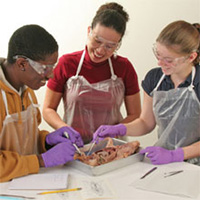Specimen Dissection Tips and FAQs

Questions about dissection or want to know more about how our specimens are produced and prepared? Find all the information you need below.
Tips for Dissection
For the safest, easiest, and most effective dissection experience in your lab, our experts recommend the following guidelines:
- ALWAYS wear gloves and eye protection
- Keep specimens moist, preserved, and mold free with Ward’Safe solution. Try a spray bottle for a handy humectant.
- Make your specimens last! Store in an airtight container using Ward’Select Concentrate for extended specimen storage over summer vacation and school breaks. Ward's Science pails are ideal for long-term storage.
- Preserved specimens do not require refrigeration of any kind. Keep away from extreme temperatures and leave in packing containers until ready to use.
- It is advisable to have the student rinse out the body cavity of a specimen when it is first opened during dissection. This will flush out clotted blood and residual embalming fluids and can be done in a laboratory sink with cold running water. The resulting waste water is easily handled by municipal wastewater treatment systems and is no cause for concern.
- Dissecting instruments should always be cleaned at the end of the class period. Simply use soap and water. Rinse in a diluted solution of household bleach (1/4 cup of bleach per gallon of water). Dry thoroughly.
- Keep your scalpels sharp! Dull scalpels are dangerous and can lead to accidents. Use a Ward's Science sharpening stone to sharpen blades. If scalpels with replaceable blades are used, change blades regularly.